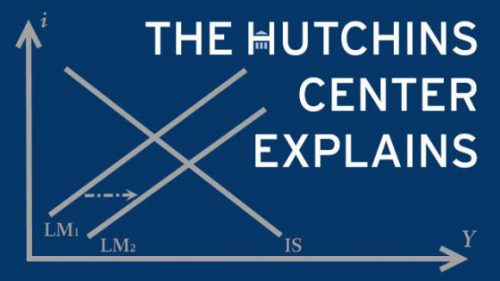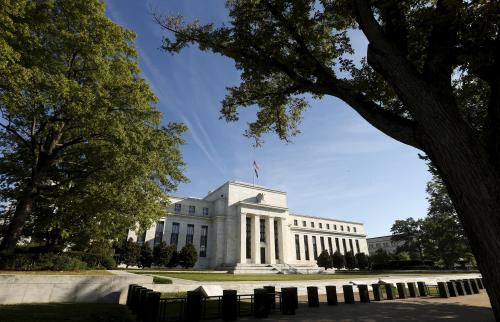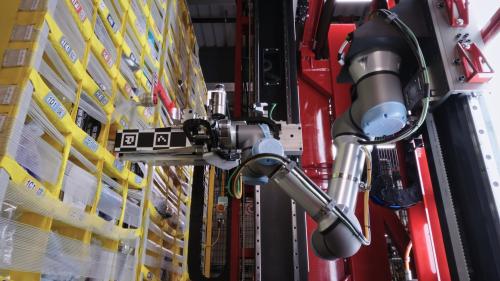Since this was posted in 2019, the Federal Reserve (in 2020) and the Reserve Bank of Australia (in 2023) have modified their inflation targets. For more on the Fed, see https://www.brookings.edu/articles/what-do-changes-in-the-feds-longer-run-goals-and-monetary-strategy-statement-mean/. For more on the RBA, see https://rbareview.gov.au/final-report and https://www.rba.gov.au/monetary-policy/framework/stmt-conduct-mp-8-2023-12-08.html.
First, what is an inflation target, and why does it matter?
The Federal Reserve is charged by Congress with maintaining price stability and maximum sustainable employment. The Fed defines “price stability” as inflation at 2 percent. In its last annual statement on its goals and monetary policy strategy, the Federal Open Market Committee—the Fed’s policy-making body—said: “Inflation at the rate of 2 percent, as measured by the annual change in the price index for personal consumption expenditures, is most consistent over the longer run with the Federal Reserve’s statutory mandate. The Committee would be concerned if inflation were running persistently above or below this objective.”
The groundwork to declare an inflation target and set it at 2 percent was laid in the 1980s when central banks around the world were eager to bring down inflation—then well above 2 percent—and saw advantages in adopting a clear, well-defined, and public objective. In 1996, when inflation was running at about 3 percent, Fed officials reached a rough consensus behind closed doors that 2 percent was a good definition of price stability. In 2012, the Fed made 2 percent the official, public target.
The Fed uses forecasts of inflation relative to the 2 percent target, along with measures of unemployment and other economic indicators, to help decide whether to raise or lower short-term interest rates. Under this framework, the Fed aims at 2 percent inflation in the future, and doesn’t compensate for periods where inflation is either above or (more relevant recently) below 2 percent. It lets bygones be bygones. (For more on the 2 percent target and alternatives to it, see “Rethinking the Fed’s 2 percent inflation target,” a report on a Hutchins Center January 2018 conference.)
The Fed is now conducting a review of its monetary policy strategy, tools, and communications practice. That review will not consider changing the Fed’s statutory mandate nor will it consider changing the 2 percent inflation objective. “It will,” the Fed says, consider whether the Fed can best meet its mandate “with its existing monetary policy strategy, whether the existing monetary policy tools are adequate to achieve and maintain the dual mandate, and whether the communications about the policy strategy and tools can be improved.”
What prompted the Fed to evaluate this framework?
One, inflation has been mostly below the 2 percent target for several years.

Two, there is widespread agreement that the neutral interest rate— the short-term real (inflation-adjusted) interest rate consistent with an economy operating at full employment with low and stable inflation – has fallen over the past couple of decades. In the 1990s, a typical estimate of the neutral rate was 2 percent or 2.5 percent. Today, Fed officials put it somewhere between 0.5 percent and 1.5 percent.
When inflation expectations are “well anchored,” as central bankers put it, the Fed can do a better job steering the economy… consumers, businesses, and markets will behave as if the Fed will keep inflation stable even if there are occasional ups and downs.
Add an inflation rate of 2 percent to that real neutral rate, and the nominal neutral rate is somewhere between 2.5 percent and 3.5 percent. That doesn’t give the Fed much room to cut interest rates by 4 or 5 percentage points as it often does in recessions. A persistently low neutral rate suggests that the Fed is likely to bump against the “zero lower bound” more often in the future than it has in the past. Once nominal rates hit zero, the Fed may not be able to cut real interest rates as much below zero as it usually does to spur borrowing and pull the economy out of recession. (At 2 percent inflation, a zero nominal interest rate is a minus 2 percent real rate.) Central bankers pay close attention not only to measures of current inflation, but also to inflation expectations. When inflation expectations are “well anchored,” as central bankers put it, the Fed can do a better job steering the economy through periods at which, for instance, oil prices rise or fall sharply; consumers, businesses, and markets will behave as if the Fed will keep inflation stable even if there are occasional ups and downs.
Here’s how John Williams, president of the Federal Reserve Bank of New York, sees the problem:
“Say that 80 percent of the time, the lower bound on interest rates does not constrain policy and the central bank aims for a 2 percent target inflation rate. During these ‘good’ times, an inflation-targeting central bank aims to keep inflation near 2 percent. But, 20 percent of the time, the economy falls into a recession that’s severe enough that the lower bound constrains policy. Assume that during these periods, inflation averages only 1 percent. So, 80 percent of the time inflation averages 2 percent and 20 percent of the time inflation averages 1 percent. The resulting average rate of inflation is about 1.8 percent. As a consequence, inflation expectations are likely to become anchored at the long-run average of 1.8 percent, below the desired 2 percent target.”
And if inflation expectations fall to 1.8 percent, then when the Fed pushes nominal rates to zero, the real rate would be only minus 1.8 percent.
So what are the alternatives to the 2 percent inflation target framework?
There are several. (See “Rethinking the Fed’s 2 percent inflation target.”) The Fed has ruled out some—such as raising the target from 2 percent to 3 percent or 4 percent. It is pondering others.
One option that has drawn increasing attention lately is called “average inflation targeting.” The major difference between this approach and the current one is that it would commit the Fed to take into account the past as well as the future. It would, for instance, promise to aim for a period where inflation is above 2 percent to compensate for a period when inflation is below 2 percent. Bygones would no longer be bygones.
As John Williams defines it:
“The central bank purposefully aims to achieve an above-target inflation rate in ‘good’ times when the lower bound is not a constraint. Properly designed and implemented, such an overshoot can offset the inflation undershoot during ‘bad’ times so that the longer-run average inflation rate and inflation expectations are in line with the target.”
Average inflation targeting has some similarities to price level targeting, which long has been popular with some academic economists. With an inflation target, the Fed aims at a particular rate of change in prices. A price level target aims at the overall level of prices. The Fed might announce, for instance, that it would aim to keep the price level increasing at a 2 percent annual rate on average over a long period. Monetary policy would consequently aim to offset periods in which inflation is below 2 percent with periods in which inflation is above 2 percent so that, over time, prices would rise by 2 percent on average. Likewise, periods of above-target inflation would be followed by periods of inflation below 2 percent. No central bank currently uses price level targeting. Sweden tried it in the 1930s. For more on price level targeting, see the Bank of Canada’s 2007 discussion paper, “Price Level Targeting,” and a presentation by James Bullard, president of the St. Louis Federal Reserve Bank. Former Fed Chair Ben Bernanke has proposed a variant that he calls temporary price level targeting that would be triggered when short-term interest rates hit zero.
Average inflation targeting is closely related, but instead of going back to when the target was originally set to make up for under- and over-shoots, average inflation targeting only goes back a given period of time. With average inflation targeting, picking that period of time over which to calculate the average is an important detail. Inflation has been below the Fed’s target for much of the last decade; if it said it would aim for above-target inflation for the next decade, as it would under price level targeting, it would risk undermining the credibility of the 2 percent target. Businesses, investors, markets, and consumers might come to expect that inflation will always be higher than 2 percent, and the Fed wants to avoid that outcome. The Fed might, instead, say it was going to look back two or three years to calculate the average. Or, as Fed Governor Lael Brainard said recently, it might aim to achieve 2 percent inflation over the business cycle. “So if inflation fell short during a recession, the Federal Reserve would aim at inflation above target during the recovery and expansion,” she said. One issue with that: It’s hard to know in real time where we are in the business cycle.
The only major central bank to embrace an average inflation target approach is Australia’s. It says it aims to keep “consumer price inflation between 2 percent and 3 percent, on average, over time.” (For a review of Australia’s experience with an inflation target, see Deputy Governor Guy Debelle’s 2018 remarks at a Reserve Bank Conference.)
Whatever the time period, were the Fed to switch to an average inflation target, it would—in times like today—do more than tolerate above 2 percent inflation for a time. It would aim for higher inflation, which implies keeping interest rates lower than it otherwise would for a time.
What’s the downside to average inflation targeting?
Given that the Fed has been unable to get inflation persistently up to 2 percent, it might have a hard time convincing people that it can get and keep inflation above 2 percent for a time.
Given that the Fed has been unable to get inflation persistently up to 2 percent, it might have a hard time convincing people that it can get and keep inflation above 2 percent for a time. And if it did, it might have a hard time convincing people that it wasn’t targeting a permanently higher pace of inflation. “There is some skepticism that a central bank would in fact prove able to support above-target inflation over a sustained period without becoming concerned that inflation might accelerate and inflation expectations might rise too high,” Gov Brainard said recently. The Fed presumably would have to explain just how much above 2 percent it was willing to let inflation go to compensate for a period of below-target inflation; that could be challenging. An even bigger challenge would be periods of above-target inflation after which the Fed would, presumably, pursue a period of below-target inflation. Imagine the Fed chair explaining at a press conference that the Fed was going to raise interest rates and increase unemployment to compensate for a period at which inflation was too high and unemployment too low.
Average inflation is getting lots of attention from Fed watchers lately. Why?
While there is academic enthusiasm for making more dramatic changes to the Fed’s framework, Fed officials have signaled a reluctance to make any big changes. “Our review is more likely to produce evolution, not a revolution, in the way that we conduct monetary policy,” Fed Vice Chair Richard Clarida said in an April 2019 speech.
That leads Fed watchers to predict a modest change from the existing framework, and average inflation targeting fits that description. As Goldman Sachs economists put it in a recent report to clients, an average inflation target is “a less radical departure from current policy” and “is easier to explain to the public” than, say, a move to a price-level target.
The Brookings Institution is committed to quality, independence, and impact.
We are supported by a diverse array of funders. In line with our values and policies, each Brookings publication represents the sole views of its author(s).







Commentary
What is “average inflation targeting”?
May 30, 2019